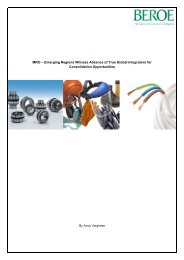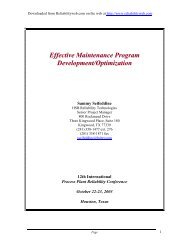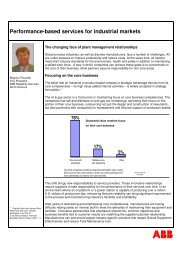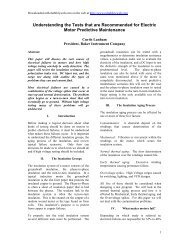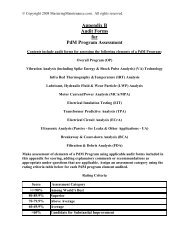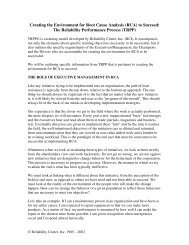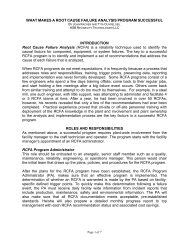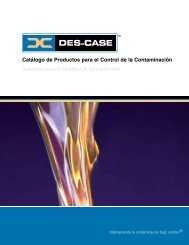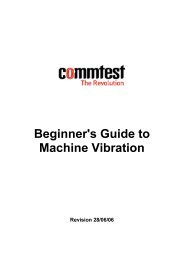PM Optimisation Maintenance Analysis of the Future
PM Optimisation Maintenance Analysis of the Future
PM Optimisation Maintenance Analysis of the Future
Create successful ePaper yourself
Turn your PDF publications into a flip-book with our unique Google optimized e-Paper software.
<strong>PM</strong> <strong>Optimisation</strong><strong>Maintenance</strong> <strong>Analysis</strong> <strong>of</strong><strong>the</strong> <strong>Future</strong>The AuthorThe author, Mr Steve Turner, is a pr<strong>of</strong>essional engineer who has been extensively trained inRCM 1 methods and has deployed <strong>the</strong>m over a 20 year period in various roles as an airworthinessengineer, a maintenance manager, as part <strong>of</strong> a design team and as a consultant. Over <strong>the</strong> pastfive years, Mr Turner has developed a process <strong>of</strong> <strong>PM</strong> <strong>Optimisation</strong> known as <strong>PM</strong>O2000. Thismethod is currently in use at 12 major industrial sites in Australia and <strong>the</strong> Asia Pacific Region1 Any reference to RCM in this paper from this point will be referring to <strong>the</strong> standard SAE JA1011.
In such organisations, it seems that <strong>the</strong> level <strong>of</strong> plant availability drops to <strong>the</strong> stage where itstabilises at a low level - a level where it is not breaking down because it is not running; ie it isbeing repaired!For many, <strong>the</strong> obvious solution is to seek to increase personnel numbers. However, thisapproach is not <strong>of</strong>ten <strong>the</strong> best. In today's economic climate, <strong>the</strong> management culture is mostlyfocussed on cost reduction and managers seeking only to increase staff numbers, rarelysucceed.Today many Asset Managers are embarking on an improvement program focussing on improving<strong>the</strong> maintenance processes and increasing <strong>the</strong> effectiveness or productivity <strong>of</strong> asset and humanresources. Improving maintenance processes involves process re-engineering and increasingresource effectiveness in <strong>the</strong> following way:• Removing all maintenance tasks that serve no purpose or are not cost effective.• Eliminating any duplication <strong>of</strong> effort where different groups are performing <strong>the</strong> same <strong>PM</strong> to<strong>the</strong> same equipment.• Moving to a mostly condition based maintenance philosophy.• Adding maintenance tasks to manage economically preventable failure modes 2 thathistorically have been run to failure.• Spreading <strong>the</strong> workload around <strong>the</strong> trades and operators.The long-term vision is to adopt such process in a way that achieves this goal in a systematic wayand which can remain as a ‘living program’ to capture <strong>the</strong> benefits <strong>of</strong> future learning and technicaladvances on a continuing basis.The methodology used to address <strong>the</strong> vicious cycle <strong>of</strong> reactive maintenance has been developedover a period <strong>of</strong> five years with <strong>the</strong> co-operation <strong>of</strong> several <strong>of</strong> Australia’s most notable assetintensive industries.The program is endorsed by SIRFrt and is <strong>the</strong> preferred maintenance analysis method <strong>of</strong> one <strong>of</strong><strong>the</strong> World’s largest mining companies. The methodology, training programs and s<strong>of</strong>twarepackage are known as <strong>PM</strong>O2000. Fur<strong>the</strong>r information can be found at www.pmoptimisation.com.2 Care must be taken as some failure modes cost more to prevent than <strong>the</strong> cost <strong>of</strong> failure itself.OMCS Ph 0419397035 www.pmoptimisation.com Page 5
SECTION 1.<strong>PM</strong>OPTIMISATION – MAINTENANCE ANALYSIS OF THE FUTUREThe Origins <strong>of</strong> <strong>Maintenance</strong> ProblemsThe Design and Commissioning Phase<strong>Maintenance</strong> engineers commonly deal with <strong>the</strong> result <strong>of</strong> someone else's design - whe<strong>the</strong>r goodor bad. When design is finished, construction starts and finishes, and <strong>the</strong> plant is commissioned.The <strong>Maintenance</strong> Engineer arrives someway through this (if he is lucky). Quickly he finds himselfleft with a maintenance budget being used to finish <strong>of</strong>f construction / over-expenditure, a plantthat is going through teething problems, spares arriving in dribs and drabs and little informationabout plant failure modes and <strong>the</strong> effect <strong>of</strong> failure. Rarely is <strong>the</strong> plant delivered to <strong>the</strong>maintenance department with a comprehensive and well-documented maintenance requirementsanalysis and a maintenance plan.What happens in best practice organisations is that, amongst o<strong>the</strong>r things, a fully documentedRCM based maintenance program is developed through <strong>the</strong> design phase. Unfortunately in <strong>the</strong>vast majority <strong>of</strong> capital projects in industry, any reliability engineering or failure analysis is done inan informal manner and certainly not provided to <strong>the</strong> maintenance department for use indeveloping asset management strategies and policies.Post CommissioningAfter commissioning, (or sometimes before) <strong>the</strong> design team disbands and its members find workon new projects. The <strong>Maintenance</strong> Engineer is left to second guess <strong>the</strong> design intent, <strong>the</strong> plantlimitations, <strong>the</strong> potential failure modes, and <strong>the</strong> likely consequences <strong>of</strong> <strong>the</strong>m. The operationspeople are, at <strong>the</strong> same time, learning how to operate <strong>the</strong> plant and experimenting with it; pushingit to its limits and occasionally well over its design intent. There is limited money or time tochange obvious design or maintainability problems in <strong>the</strong> new plant.The task <strong>of</strong> defining <strong>the</strong> plant maintenance policy 3 is a priority but a most daunting one.Whatever is achieved is done in a rush <strong>of</strong>ten using people in an opportunistic manner. Theproblems that emerge right from <strong>the</strong> beginning will be as follows:• There is no consistency <strong>of</strong> analysis philosophy.• <strong>Maintenance</strong> personnel, being risk averse, write maintenance policies which over service anduse overhaul or intrusive methods as a means <strong>of</strong> prevention - <strong>of</strong>ten to <strong>the</strong> detriment <strong>of</strong>reliability ra<strong>the</strong>r than for its good 4 .• There is no audit trail, and only those who wrote <strong>the</strong> policies know <strong>the</strong>ir rationale. It becomesnear impossible to review <strong>the</strong> program and objectively assess its effectiveness.Full ProductionWhen <strong>the</strong> plant swings into full operation and breaks down, more maintenance tasks are createdand some existing tasks are done more frequently. Many <strong>of</strong> <strong>the</strong>se new tasks duplicate o<strong>the</strong>rs.Often, in an attempt to be seen to be doing something about high pr<strong>of</strong>ile reliability problems,3 A maintenance policy is <strong>the</strong> combination <strong>of</strong> what is to be done, how frequently and by whom.4 Particularly if <strong>the</strong> maintenance is intrusiveOMCS Ph 0419397035 www.pmoptimisation.com Page 7
SECTION 1.<strong>PM</strong>OPTIMISATION – MAINTENANCE ANALYSIS OF THE FUTUREmaintenance personnel create and perform tasks supposed to prevent <strong>the</strong> failures but, in reality,serve no realistic purpose.Soon <strong>the</strong> preventive maintenance (<strong>PM</strong>) requirements exceed <strong>the</strong> labour resource available. <strong>PM</strong>is missed, preventable failures occur and unplanned maintenance work consumes more labourthan necessary. The number <strong>of</strong> temporary repairs grows out <strong>of</strong> control and <strong>the</strong> costs <strong>of</strong> revisiting<strong>the</strong>m or repairing additional damage caused by <strong>the</strong>m wastes more resources.The vicious circle <strong>of</strong> breakdown maintenance, temporary repair, and reduced <strong>PM</strong> gainsmomentum and becomes well entrenched.Management Consultants (<strong>of</strong>ten with a cost reduction focus) arrive on site and cut staff numbersand budgets. This serves only to tighten <strong>the</strong> vicious circle and increase <strong>the</strong> rpm. The end resultis typically a large morale problem for <strong>the</strong> maintenance department and a poorly performing plant.Many organisations have tried to regain control by using RCM to develop <strong>the</strong>ir maintenanceprogram. This is <strong>of</strong>ten a pursuit with limited scope and a high failure rate. This is because RCMis highly inefficient when used as a rationalisation tool. It consumes excessive amounts <strong>of</strong> <strong>the</strong>most valuable resources on site - those being <strong>the</strong> scarce maintenance and operations personnel.A large element <strong>of</strong> <strong>the</strong> inefficiency <strong>of</strong> RCM, is that it does not acknowledge <strong>the</strong> experience andvalue <strong>of</strong> <strong>the</strong> current maintenance program. It starts from scratch and builds a maintenanceprogram from <strong>the</strong> function down.The high failure rate <strong>of</strong> RCM amongst mature operations is not surprising when it is realised thatRCM was developed by Nolan and Heap (Nolan and Heap, 1978) for use in <strong>the</strong> design phase <strong>of</strong><strong>the</strong> equipment life cycle (Moubray 1997). It was not designed for use in mature industries as arationalisation tool.Improvement TacticsThe Dupont Experience - Four Common StrategiesIn this predicament, case studies and experience suggest that, outside <strong>of</strong> cultural and behaviouralinitiatives, asset managers should be focussing on a few key areas. They must:• Develop focussed maintenance policies,• Improve planning and scheduling based on <strong>the</strong> revised policies, and• Focus on defect elimination.The DuPont model <strong>of</strong> Up-Time featured in <strong>the</strong> Manufacturing Game 5 illustrates <strong>the</strong>se points verywell. The table below illustrates how DuPont has modelled <strong>the</strong> relative effect <strong>of</strong> various strategieson plant uptime.5 The manufacturing game is a practical learning process where participants learn in aninteractive environment, <strong>the</strong> strategies which will best enhance plant uptime. The game isavailable through SIRF Roundtable. Information is readily available athttp://www.manufacturinggame.com.OMCS Ph 0419397035 www.pmoptimisation.com Page 8
SECTION 1.<strong>PM</strong>OPTIMISATION – MAINTENANCE ANALYSIS OF THE FUTUREDuPont analysis suggests that if companies focus on planning only <strong>the</strong>y will improve <strong>the</strong>ir uptimeby 0.5%. If <strong>the</strong>y focus only on maintenance scheduling, uptime will improve by 0.8%. If <strong>the</strong>yfocus on preventive and predictive maintenance only, uptime will actually get worse by 2.4%. Iforganisations focus on all <strong>of</strong> <strong>the</strong>se three aspects, <strong>the</strong>y will receive a 5.1% improvement inavailability.These results may well sound appealing in <strong>the</strong>ir own right, but DuPont has found that by addingdefect elimination to <strong>the</strong> initiatives undertaken, <strong>the</strong>n a 14.8% improvement in availability may beachieved in <strong>the</strong>ir plants. This information is provided in <strong>the</strong> table at Figure 2.Strategy Change % Uptime %Reactive 83.5%Planning OnlyScheduling OnlyPreventive / Predictive Only+ 0.5%+0.8%-2.4%All Three Strategies +5.1% 88.6%Plus Defect Elimination +14.8% 98.3%Figure 2 Table showing <strong>the</strong> effect <strong>of</strong> different reliability engineering activities on plant availabilitytaken from <strong>the</strong> Manufacturing Game - SIRFrt. http://www.manufacturinggame.com/Problems with most <strong>PM</strong> ProgramsThe common problem with mature maintenance programs that were never designed correctly in<strong>the</strong> first place, is that between 40% and 60% <strong>of</strong> <strong>the</strong> <strong>PM</strong> tasks serve very little purpose (Moubray,1997). The findings <strong>of</strong> many <strong>PM</strong>O reviews are that:• Many tasks duplicate o<strong>the</strong>r tasks.• Some tasks are done too <strong>of</strong>ten (and some too late).• Some tasks serve no purpose whatsoever.• Many tasks will be intrusive and overhaul based whereas <strong>the</strong>y should be condition based.• There are many costly preventable failures happening.This poses a significant issue for improving productivity as no amount <strong>of</strong> perfect planning andscheduling will make up for <strong>the</strong> inefficiencies <strong>of</strong> <strong>the</strong> maintenance program itself. Achieving 100%compliance with a program that is 50% useful and 50% wasteful can not be good assetmanagement!The DuPont analysis indicates that a process must be implemented that:• Can define <strong>the</strong> appropriate mix <strong>of</strong> preventive and predictive maintenance,OMCS Ph 0419397035 www.pmoptimisation.com Page 9
SECTION 1.<strong>PM</strong>OPTIMISATION – MAINTENANCE ANALYSIS OF THE FUTURE• Can produce a maintenanceprogram where <strong>the</strong> servicingintervals and <strong>the</strong> tasks<strong>the</strong>mselves are sound andvalue adding in every case, and• Where defects which can not bemaintained out <strong>of</strong> <strong>the</strong> plant canbe eliminated through o<strong>the</strong>rmeans.Figure 3 Illustration <strong>of</strong> how <strong>PM</strong>O works<strong>PM</strong>Not DoneBefore <strong>PM</strong>O<strong>PM</strong>Not DoneAfter <strong>PM</strong>OWhat is suggested, as afundamental building block inadopting all <strong>the</strong>se strategies, is toensure all work undertaken is basedon RCM decision logic. <strong>PM</strong>O is ameans <strong>of</strong> rationalising all <strong>the</strong>Preventive <strong>Maintenance</strong> work toensure that all <strong>the</strong> work adds valueand <strong>the</strong>re are no duplications <strong>of</strong>effort. Figure 3 illustrates this.Resourcesto Do <strong>PM</strong>Effective <strong>PM</strong>Resourcesto Do <strong>PM</strong>Useless <strong>PM</strong><strong>PM</strong>O 2000 from A to Z.OverviewThe <strong>PM</strong>O 2000 process has nine steps. These steps are listed below and discussed in <strong>the</strong>following pages.Step 1 Task CompilationStep 2 Failure Mode <strong>Analysis</strong>Step 3 Rationalisation and FMA ReviewStep 4 Functional <strong>Analysis</strong> (Optional)Step 5 Consequence EvaluationStep 6 <strong>Maintenance</strong> Policy DeterminationStep 7 Grouping and ReviewStep 8 Approval and ImplementationStep 9 Living ProgramOMCS Ph 0419397035 www.pmoptimisation.com Page 10
SECTION 1.<strong>PM</strong>OPTIMISATION – MAINTENANCE ANALYSIS OF THE FUTUREProject RankingIt should be noted that a full <strong>PM</strong>O 2000 assignment, <strong>the</strong>re may need to be some form <strong>of</strong> criticalityor system ranking process. This may be done by reviewing <strong>the</strong> equipment hierarchy or workschedule hierarchy 6 , and subdividing it into appropriate systems and/or equipment items or tradefiltered maintenance schedules for analysis. Having performed this task, <strong>the</strong> criticality <strong>of</strong> each <strong>of</strong><strong>the</strong> project is identified is assessed in terms <strong>of</strong> <strong>the</strong>ir contribution to <strong>the</strong> client organisation’sstrategic objectives. Higher criticality systems tend to be those that will have an impact in <strong>the</strong>following ways:♦ Have a high perceived risk in terms <strong>of</strong> achieving safety or environmental objectives,♦ Have a significant impact on plantthroughput, operating or maintenancecosts, or♦ Are consuming excessive labour tooperate and maintain.Having conducted <strong>the</strong> criticality assessment,this is used as <strong>the</strong> basis for assessing whichprojects should be analysed first, and <strong>the</strong>overall level <strong>of</strong> rigour required for eachanalysis.STEP 1- Task CompilationComputerised<strong>Maintenance</strong>ManagementSystems.ContractorSchedules.Vendor<strong>Maintenance</strong>Manuals.Sources <strong>of</strong> Preventive <strong>Maintenance</strong>OperatorRounds.StandardOperatingProceduresConditionMonitoringRounds.Memory andTraditionLubricationRounds.<strong>PM</strong> <strong>Optimisation</strong> starts by collecting ordocumenting <strong>the</strong> existing maintenanceprogram (formal or informal) and loading itinto a database via a spreadsheet. It is Figure 4 - Sources <strong>of</strong> <strong>PM</strong> Programsimportant to realise that maintenance isperformed by a wide cross section <strong>of</strong> people including operators. It is also important to realisethat in many organisations, most <strong>of</strong> <strong>the</strong> Preventive <strong>Maintenance</strong> program is done by <strong>the</strong> initiative<strong>of</strong> <strong>the</strong> tradesmen or operators and not documented formally. In this situation, task compilation isa simple matter <strong>of</strong> writing down what <strong>the</strong> people are doing. It is common for organisations tohave an informal <strong>PM</strong> system in operation whilst it is rare for an organisation to have no <strong>PM</strong> at all.Figure 4 illustrates <strong>the</strong> sources <strong>of</strong> <strong>PM</strong> programs.Step 2 - Failure Mode <strong>Analysis</strong>Step 2 involves people from <strong>the</strong> shop floorworking in cross-functional teamsidentifying what failure mode(s) eachmaintenance task (or inspection) is meantto address. Figure 5 illustrates <strong>the</strong> output<strong>of</strong> Step 2.Task Interval Trade FailureTask 1 Daily Operator Failure ATask 2 Daily Operator Failure BTask 3 6 Months Fitter Failure CTask 4 6 Months Fitter Failure ATask 5 Annual Electrician Failure BTask 6 Weekly Operator Failure CFigure 5 - Illustration <strong>of</strong> Step 26 <strong>PM</strong>O can be conducted on any trade schedule such as lube rounds or operator rounds and canalso be used to analyse <strong>the</strong> <strong>PM</strong> needs <strong>of</strong> a major shut down.OMCS Ph 0419397035 www.pmoptimisation.com Page 11
SECTION 1.<strong>PM</strong>OPTIMISATION – MAINTENANCE ANALYSIS OF THE FUTUREStep 3 - Rationalisation and Failure ModeReviewThrough grouping <strong>the</strong> data by failure mode,task duplication can be easily identified. Taskduplication is where <strong>the</strong> same failure mode ismanaged by <strong>PM</strong> conducted by more than onesection, and is most commonly found betweenoperators and trades, and trades and conditionmonitoring specialists.In this step, <strong>the</strong> team reviews <strong>the</strong> failure modesgenerated through <strong>the</strong> Failure Mode <strong>Analysis</strong>and adds missing failures to <strong>the</strong> list. The list <strong>of</strong>missing failures is generated through ananalysis <strong>of</strong> failure history, technicaldocumentation (usually P&Ids) or <strong>the</strong> experience <strong>of</strong>Task Trade CauseTask 1 Operator Failure ATask 4 Fitter Failure ATask 7 Greaser Failure ATask 2 Operator Failure BTask 5 Electrician Failure BTask 3 Fitter Failure CTask 6 Operator Failure CFailure DFigure 6 - Illustration <strong>of</strong> Step 3<strong>the</strong> team. Figure 6 illustrates <strong>the</strong> output <strong>of</strong> Step 3. Note <strong>the</strong> addition <strong>of</strong> a new failure cause “D”that has been identified during this step. Failure D could have come from failure history orscrutiny <strong>of</strong> technical documentation.Step 4 - Functional<strong>Analysis</strong>The functions lost due toeach failure mode can beestablished in this step.This task is optional, andmay be justified foranalyses on highly criticalor very complex equipmentitems, where soundunderstanding <strong>of</strong> all <strong>the</strong>equipment functions is anessential part <strong>of</strong> ensuring acomprehensiveTask Trade Cause FunctionTask 1 Operator Failure A Function 1Task 4 Fitter Failure ATask 7 Greaser Failure ATask 2 Operator Failure B Function 1Task 5 Electrician Failure BTask 3 Fitter Failure C Function 2Task 6 Operator Failure CFailure D Function 1Figure 7 - Illustration <strong>of</strong> Step 4maintenance program. For less critical items, or simple systems, identifying all <strong>of</strong> <strong>the</strong> functions <strong>of</strong>an equipment item adds cost and time, but yields no benefits. Figure 7 illustrates Step 4.Step 5 - Consequence EvaluationIn Step 5, each failure mode isanalysed to determine whe<strong>the</strong>r ornot <strong>the</strong> failure is hidden or evident.For evident failures a fur<strong>the</strong>rdetermination <strong>of</strong> hazard oroperational consequence is made.Figure 8 illustrates Step 5.Task Trade Cause Function EffectTask 1 Operator Failure A Function 1 OperationTask 4 Fitter Failure ATask 7 Greaser Failure ATask 2 Operator Failure B Function 1 OperationTask 5 Electrician Failure BTask 3 Fitter Failure C Function 2 HiddenTask 6 Operator Failure CFailure D Function 1 OperationFigure 8 Illustration <strong>of</strong> Step 5OMCS Ph 0419397035 www.pmoptimisation.com Page 12
SECTION 1.<strong>PM</strong>OPTIMISATION – MAINTENANCE ANALYSIS OF THE FUTUREStep 6 - <strong>Maintenance</strong> Policy DeterminationModern maintenance philosophy stems from <strong>the</strong> premise that successful maintenance programshave more to do with <strong>the</strong> consequences <strong>of</strong> failures than <strong>the</strong> asset itself.In this step, each failure mode is analysed using Reliability Centred <strong>Maintenance</strong> (RCM)principles. This step establishes new or revised maintenance policies. During this step <strong>the</strong>following become evident:‣ The elements <strong>of</strong> <strong>the</strong> current maintenance program that are cost effective, and those that arenot (and need to be eliminated),‣ What tasks would be more effective and less costly if <strong>the</strong>y were condition based ra<strong>the</strong>r thanoverhaul based and vice versa,‣ What tasks serve no purpose and need to be removed from <strong>the</strong> program,‣ What tasks would be more effective if <strong>the</strong>y were done at different frequencies,‣ What failures would bebetter managed byusing simpler or moreadvanced technology,‣ What data should becollected to be able topredict equipment lifemore accurately, and‣ What defects shouldbe eliminated by rootcause analysis.Cause Function Effect Policy IntervalFailure A Function 1 Operation Inspect DailyFailure B Function 1 Operation No <strong>PM</strong>Failure C Function 2 Hidden Test AnnuallyFailure D Function 1 Operation Inspect WeeklyFigure 9 Illustration <strong>of</strong> Step 6Figure 9 illustrates Step 6.Step 7 - Grouping and ReviewOnce task analysis has been completed, <strong>the</strong> team establishes <strong>the</strong> most efficient and effectivemethod for managing <strong>the</strong> maintenance <strong>of</strong> <strong>the</strong> asset given local production factors and o<strong>the</strong>rconstraints. In this step it is likely that tasks will be transferred between trades and operationspeople for efficiency and productivity gains.Step 8 - Approval and ImplementationIn Step 8, <strong>the</strong> analysis is communicated to local stakeholders for review and comment. Thegroup <strong>of</strong>ten does this via a presentation and an automatic report generated from <strong>the</strong> <strong>PM</strong><strong>Optimisation</strong> s<strong>of</strong>tware. This s<strong>of</strong>tware details all <strong>the</strong> changes and <strong>the</strong> justification for each.Following approval, <strong>the</strong> most important aspect <strong>of</strong> <strong>PM</strong>O 2000 <strong>the</strong>n commences withimplementation. Implementation is <strong>the</strong> step that is most time consuming and most likely to facedifficulties. Strong leadership and attention to detail are required to be successful in this step.OMCS Ph 0419397035 www.pmoptimisation.com Page 13
SECTION 1.<strong>PM</strong>OPTIMISATION – MAINTENANCE ANALYSIS OF THE FUTUREThe difficulty <strong>of</strong> this step increases markedly with more shifts and also with organisations thathave not experienced much change.Step9 - Living ProgramThrough Steps 1 to 9, <strong>the</strong> <strong>PM</strong> <strong>Optimisation</strong> process has established a framework <strong>of</strong> rational andcost effective <strong>PM</strong>. In <strong>the</strong> "Living Program", <strong>the</strong> <strong>PM</strong> program is consolidated and <strong>the</strong> plant isbrought under control. This occurs as reactive maintenance is replaced by planned maintenance.From this point improvement can be easily accelerated as resources are freed to focus on plantdesign defects or inherent operational limitations.During this step, several vital processes for <strong>the</strong> efficient management <strong>of</strong> assets can be devised orfine tuned as <strong>the</strong> rate <strong>of</strong> improvement accelerates.These processes include <strong>the</strong> following:‣ Production / maintenance strategy,‣ Performance measurement,‣ Failure history reporting and defect elimination,‣ Planning and scheduling,‣ Spares assessing, and‣ Workshop and maintenance practices.In this step it is <strong>the</strong> intention to create an organisation that constantly seeks to improve itsmethods by continued appraisal <strong>of</strong> every task it undertakes and every unplanned failure thatoccurs. To achieve this requires a program where <strong>the</strong> workforce is adequately trained in analysistechniques and is encouraged to change practices to improve <strong>the</strong>ir own job satisfaction and toreduce <strong>the</strong> reduce <strong>the</strong> unit cost <strong>of</strong> production.Implementing a Successful <strong>PM</strong> <strong>Optimisation</strong> ProgramSelling <strong>Maintenance</strong> as a Process ra<strong>the</strong>r than a DepartmentChange programs are not easy to implement particularly when an organisation has entered <strong>the</strong>vicious circle <strong>of</strong> maintenance.The author's experience is that in most cases <strong>the</strong>re needs to be some fundamental shifts inbehaviour and motives at all levels across <strong>the</strong> organisation. This almost invariably involvesmodifying <strong>the</strong> behaviour and decision-making priorities for middle managers too. Above all, <strong>the</strong>reneeds to be a commitment to <strong>the</strong> long term and if <strong>the</strong>re needs to be some short-term losses, <strong>the</strong>n<strong>the</strong>se will <strong>of</strong>ten be well worth it if returns can be generated quickly from <strong>the</strong> investment in <strong>the</strong>future.The most important aspects <strong>of</strong> managing a <strong>PM</strong> <strong>Optimisation</strong> change program to break <strong>the</strong> viciouscycle, are described in <strong>the</strong> following paragraphs:OMCS Ph 0419397035 www.pmoptimisation.com Page 14
SECTION 1.<strong>PM</strong>OPTIMISATION – MAINTENANCE ANALYSIS OF THE FUTUREbecause <strong>the</strong> project has consumed scarce resources and wasted <strong>the</strong>m. Without successfulimplementation, <strong>the</strong> work has created a cost and <strong>the</strong> workforce expectations have not been met.The workforce will correctly blame <strong>the</strong> middle management and participation in future projects willbe more difficult to obtain.Dysfunctional Organisational StructuresThe organisational structure <strong>of</strong> most capital intensive industries can be described as beingdepartmentalised with maintenance and operations having separate budgets, performancemeasures, and management structures. There are advantages associated with departmentalisedorganisational structures; however, such structures <strong>of</strong>ten lose efficiency through:• Conflicting goals and objectives <strong>of</strong> each department that sometimes result in decisions whichare not congruent with <strong>the</strong> overall business goals. The most common being short-termproduction goals that <strong>of</strong>ten clash with <strong>the</strong> maintenance objective <strong>of</strong> reducing <strong>the</strong> overall cost<strong>of</strong> maintenance.• Duplication <strong>of</strong> effort with many departments attempting to achieve <strong>the</strong> same result but inisolation <strong>of</strong> each o<strong>the</strong>r. Electrical, mechanical and production <strong>PM</strong> schedules commonly fallinto this category with each department checking <strong>the</strong> same machine for <strong>the</strong> same failuremodes.• An overly bureaucratic decision making and approval process at all levels. This is <strong>of</strong>ten aresult <strong>of</strong> conflicting objectives between managers.• Excessive demarcation <strong>of</strong> roles and responsibilities. Though becoming less prevalent, <strong>the</strong>inability to take responsibility for certain work due to past traditions prevents efficient use <strong>of</strong>resources at many sites.• A proliferation <strong>of</strong> independent systems and databases. The most common instance is whereoperations and maintenance personnel work through <strong>the</strong>ir own logbooks and records that arekept independently <strong>of</strong> <strong>the</strong> CMMS.• The process <strong>of</strong> defect elimination is seen largely as an engineering pursuit where problems<strong>of</strong>ten have multiple contributing factors and must be solved by cross functional teams. Manyfactors are not necessarily obvious and many are due to shop floor people taking practicalmeasures to combat o<strong>the</strong>r problems that have secondary effects elsewhere.ConclusionThere are a number <strong>of</strong> contributing factors to <strong>the</strong> difficulties faced by <strong>the</strong> modern asset manager.To be effective at making changes to <strong>the</strong> performance <strong>of</strong> a maintenance function, <strong>the</strong> assetmanager should understand how <strong>the</strong>se factors have arisen, how <strong>the</strong>y impact on <strong>the</strong> businessperformance and how <strong>the</strong>y can be effectively tackled. There is a way out <strong>of</strong> <strong>the</strong> vicious cycle <strong>of</strong>maintenance and <strong>the</strong> <strong>Optimisation</strong> or Rationalisation <strong>of</strong> <strong>Maintenance</strong> tasks is a fundamentalstrategy in this process.To break <strong>the</strong> vicious cycle <strong>of</strong> maintenance, asset managers should focus on <strong>the</strong> areas <strong>of</strong>preventive maintenance and defect elimination. To improve <strong>the</strong>ir preventive maintenanceorganisations, <strong>the</strong>re must be a shift to an environment where <strong>the</strong>re is no duplication <strong>of</strong> <strong>PM</strong> effort,every <strong>PM</strong> task serves a purpose, all <strong>PM</strong> tasks are completed at <strong>the</strong> right interval, and with <strong>the</strong>right mix <strong>of</strong> condition based maintenance and overhaul.OMCS Ph 0419397035 www.pmoptimisation.com Page 16
SECTION 1.<strong>PM</strong>OPTIMISATION – MAINTENANCE ANALYSIS OF THE FUTUREOrganisations that have mature <strong>PM</strong> programs and are struggling to complete <strong>the</strong>m should takesteps to rationalise what <strong>the</strong>y have, ra<strong>the</strong>r than embarking on a “green field” approach such as<strong>the</strong> traditional approaches to RCM.There are many statistically based maintenance analysis tools available, however, users shouldbe careful in <strong>the</strong>ir choice. They should be mindful that <strong>the</strong>y could be spending a lot <strong>of</strong> money onexpensive packages and consuming a lot <strong>of</strong> time collecting vague data which, after years <strong>of</strong>effort, produces a meaningless result.OMCS Ph 0419397035 www.pmoptimisation.com Page 17
SECTION 2. COMPARING <strong>PM</strong>O AND RCM METHODS OF MAINTENANCE ANALYSISComparing <strong>PM</strong>O and RCM Methods <strong>of</strong> <strong>Maintenance</strong> <strong>Analysis</strong>Methods <strong>of</strong> defining Initial <strong>Maintenance</strong> RequirementsThe common methods for defining <strong>the</strong> initial maintenance requirements for plant and equipmentare as follows:RCM,Streamlined RCM,Statistical Methods, orExperience, trial and error.The origin <strong>of</strong> <strong>the</strong> processes is briefly discussed below.RCMNolan and Heap (1978) coined <strong>the</strong> term Reliability Centred <strong>Maintenance</strong> (RCM) and developed<strong>the</strong> original method. RCM was not designed for use for “in service” assets. However, in <strong>the</strong>absence <strong>of</strong> better methods since 1978, it has been applied retrospectively in many organisationsafter <strong>the</strong> plant has been commissioned. In over 20 year since its derivation, RCM has failed tobecome a day to day activity performed by most organisations. Few organisations have appliedRCM to anything o<strong>the</strong>r than <strong>the</strong>ir most critical assets which indicates <strong>the</strong>re are serious difficultiesassociated with applying RCM in organisations with mature plant.Streamlined RCMDue to a perception that RCM was a very time consuming and labour intensive activity, a number<strong>of</strong> shortened versions <strong>of</strong> RCM have been devised in an attempt to speed up <strong>the</strong> analysis orincrease <strong>the</strong> overall value <strong>of</strong> <strong>the</strong> time committed to analysis. Many <strong>of</strong> <strong>the</strong>se methods have used<strong>the</strong> acronym, RCM to describe <strong>the</strong> process but do not conform to <strong>the</strong> works <strong>of</strong> Nolan and Heap(1978) nor <strong>the</strong> SAE Standard for RCM. These streamlined approaches are known as streamlinedRCM techniques.Statistical MethodsThere are three main types <strong>of</strong> statistical maintenance analysis programs known to <strong>the</strong> author.1. One <strong>of</strong> <strong>the</strong>se is based on MILSTD 2173 and works from <strong>the</strong> premise that no inspection task is100% effective. The algorithms adjust <strong>the</strong> interval <strong>of</strong> “on condition” tasks to account for lessthan perfect inspection methods.2. Ano<strong>the</strong>r is based on <strong>the</strong> notion that <strong>the</strong> more frequent <strong>the</strong> inspection <strong>the</strong> higher <strong>the</strong> cost <strong>of</strong>maintenance but <strong>the</strong> lower <strong>the</strong> chances <strong>of</strong> failure. The objective <strong>of</strong> maintenance under thisalgorithm is to determine <strong>the</strong> lowest overall cost <strong>of</strong> maintenance. This algorithm is flawed ifinspection is near 100% reliable or is fail safe 8 as, providing <strong>the</strong> inspection is inside <strong>the</strong> PF8 Any incorrect sample will suggest <strong>the</strong>re is a failure when in fact <strong>the</strong>re is not. Oil analysis orvibration analysis are examples where most <strong>of</strong> <strong>the</strong> problems are fail-safe.OMCS Ph 0419397035 www.pmoptimisation.com Page 18
SECTION 2. COMPARING <strong>PM</strong>O AND RCM METHODS OF MAINTENANCE ANALYSISinterval, more inspections only add to <strong>the</strong> cost <strong>of</strong> maintenance but not reduce <strong>the</strong> chances <strong>of</strong>failure.3. The third statistical method has uses to Weibull analysis as a basis. This method suffersmostly from poor data integrity.The overwhelming problem with statistical methods in <strong>the</strong> vast majority <strong>of</strong> industrial plant is that<strong>the</strong> failure history data is so unreliable and incomplete that any statistical inferences drawn fromsuch data are wildly inaccurate and lack any worthwhile statistical confidence. The algorithmsare also reliant on accounting inputs such as <strong>the</strong> cost <strong>of</strong> <strong>PM</strong>, repair and failure. All <strong>of</strong> <strong>the</strong>se inputsare subject to <strong>the</strong> vagaries <strong>of</strong> <strong>the</strong> accounting systems deployed.The second large problem is that statistical methods tend to be used by engineers or contractorswho are not sufficiently familiar with <strong>the</strong> equipment an <strong>the</strong> manner that it is used on site. Often<strong>the</strong> result is a misguided program which is totally discredited by <strong>the</strong> tradesmen and operatorsbecause <strong>of</strong> its low quality and secondly because <strong>the</strong>y were not sufficiently involved in itsderivation.Some explanation <strong>of</strong> <strong>the</strong> first two methods is contained at Section 3 <strong>of</strong> this paper.Experience, Trial and ErrorIn many cases, capital acquisition programs fail to recognise <strong>the</strong> need to define <strong>the</strong> maintenanceprogram prior to <strong>the</strong> “Operation” stage <strong>of</strong> <strong>the</strong> equipment life cycle. Often, <strong>the</strong> plant is installedand operated without a formal maintenance program. Over time, <strong>the</strong> operations andmaintenance staff begin to conduct inspections and perform various maintenance activitieslargely at <strong>the</strong>ir own initiative. Failures occur and <strong>the</strong> maintenance program has tasks added to it.In some organisations, <strong>the</strong> work is formalised by generating electronic or paper basedmaintenance schedules. In o<strong>the</strong>r organisations, <strong>the</strong> work continues to be done in a completelyinformal manner. Even though some managers may believe that <strong>the</strong>re is no preventivemaintenance done within <strong>the</strong>ir plant, this situation is highly unlikely. The confusion is <strong>of</strong>ten that<strong>the</strong> preventive maintenance is not appreciated, as <strong>the</strong>re is no documentation.Methods <strong>of</strong> Reviewing <strong>Maintenance</strong> Requirements<strong>PM</strong> <strong>Optimisation</strong>Regardless <strong>of</strong> how a maintenance program has been developed, <strong>the</strong>re is a constant need toreview and update <strong>the</strong> program based on failure history, changing operating circumstances and<strong>the</strong> advent <strong>of</strong> new predictive maintenance technologies. The generic process used to performsuch analyses is known as <strong>PM</strong> <strong>Optimisation</strong> (<strong>PM</strong>O). <strong>PM</strong>O has been performed, no doubt, since<strong>the</strong> world became mechanised and humans realised <strong>the</strong> benefits <strong>of</strong> performing preventivemaintenance. <strong>PM</strong>O as a technique has been refined to reflect <strong>the</strong> RCM decision logic since <strong>the</strong>formulation <strong>of</strong> RCM in 1978.There are a number <strong>of</strong> methods that have been created under <strong>the</strong> acronym <strong>PM</strong>O. One <strong>of</strong> <strong>the</strong>sehas been applied in <strong>the</strong> US Nuclear power industry for over 8 years and has been recognised asa major benefit by <strong>the</strong> North American Nuclear Regulatory Commission (Johnson 1995).Each <strong>of</strong> <strong>the</strong> <strong>PM</strong>O methods has differences and <strong>the</strong>re is no accepted standard for <strong>PM</strong>O.Discussions contained in this paper are <strong>the</strong>refore, based on <strong>the</strong> method <strong>of</strong> <strong>PM</strong>O known as<strong>PM</strong>O2000. Some <strong>of</strong> <strong>the</strong> comments and comparisons made between <strong>PM</strong>O and o<strong>the</strong>r methodsmay not apply to methods <strong>of</strong> <strong>PM</strong>O.OMCS Ph 0419397035 www.pmoptimisation.com Page 19
SECTION 2. COMPARING <strong>PM</strong>O AND RCM METHODS OF MAINTENANCE ANALYSISThe <strong>PM</strong>O2000 process has been developed over a five-year period by OMCS with <strong>the</strong> assistance<strong>of</strong> several Australian Companies. There are now 12 users <strong>of</strong> <strong>PM</strong>O2000 in <strong>the</strong> Australia PacificRegion. The <strong>PM</strong>O2000 process is endorsed by SIRF Roundtables Ltd 9 and is <strong>the</strong> globalmaintenance analysis tool <strong>of</strong> choice for one <strong>of</strong> <strong>the</strong> world’s largest mining companies. <strong>PM</strong>O2000is <strong>the</strong> intellectual property <strong>of</strong> OMCS. The methodology is described in detail at Section 1.Comparing RCM and <strong>PM</strong>OWhat is RCMAccording to <strong>the</strong> standard SAEJA1011, any RCM program should ensure that all <strong>of</strong> <strong>the</strong> followingseven questions are answered satisfactorily and are answered in <strong>the</strong> sequence shown:1. What are <strong>the</strong> functions and associated desired standards <strong>of</strong> performance <strong>of</strong> <strong>the</strong> asset in itspresent operating context (functions)?2. In what ways can it fail to fulfil its functions (functional failures)?3. What causes each functional failure (failure modes)?4. What happens when each failure occurs (failure effects)?5. In what way dose each failure matter (failure consequences)?6. What should be done to predict or prevent each failure (proactive tasks and task intervals)?7. What should be done if a suitable proactive task cannot be found (default actions)?What is <strong>PM</strong> <strong>Optimisation</strong>The questions answered in completing a <strong>PM</strong>O2000 analysis are as follows:1) What maintenance tasks are being undertaken by <strong>the</strong> operations and maintenance personnel(task compilation)?2) What are <strong>the</strong> failure modes associated with <strong>the</strong> plant being examined (failure modeanalysis)?a) What is (are) <strong>the</strong> failure mode(s) that each existing task is meant to prevent or detectb) What o<strong>the</strong>r failure modes have occurred in <strong>the</strong> past that have not been listed or have notoccurred and could give rise to a hazardous situation.3) What functions would be lost if each failure were to occur unexpectedly (functions)? [optionalquestion]9 SIRF Roundtables Ltd was formed on 1 July 2000 out <strong>of</strong> <strong>the</strong> Strategic Industry ResearchFoundation Ltd as a result <strong>of</strong> <strong>the</strong> foundation's withdrawal from its industry shared learningnetworks (including <strong>the</strong> IMRt) and related support activities.OMCS Ph 0419397035 www.pmoptimisation.com Page 20
SECTION 2. COMPARING <strong>PM</strong>O AND RCM METHODS OF MAINTENANCE ANALYSIS4) What happens when each failure occurs (failure effects)?5) In what way does each failure matter (failure consequences)?6) What should be done to predict or prevent each failure (proactive tasks and task intervals)?7) What should be done if a suitable proactive task cannot be found (default actions)?The complete <strong>PM</strong>O2000 methodology has nine steps. The seven questions listed above are asubset <strong>of</strong> <strong>the</strong> complete <strong>PM</strong>O2000 methodology. The additional steps in <strong>PM</strong>O2000 not listedabove are as follows:• Grouping and Review• Approval and Implementation• Living ProgramThese final three steps are necessary to implement <strong>the</strong> analysis outputs and ensure that <strong>the</strong><strong>PM</strong>O analysis does not stop once <strong>the</strong> first review has been completed. These steps are notconsidered relevant to this paper as it is assumed that RCM analysis must also perform <strong>the</strong>sesteps to ensure a successful outcome. RCM and <strong>PM</strong>O are considered identical in this regard.Functional Differences between RCM and <strong>PM</strong>ORCM and <strong>PM</strong>O are completely different products with <strong>the</strong> same aim; to define <strong>the</strong> maintenancerequirements <strong>of</strong> physical assets. Asset managers should be aware however, <strong>the</strong>y have beendesigned for use in completely different situations. RCM was designed to develop <strong>the</strong> initialmaintenance program during <strong>the</strong> design stages <strong>of</strong> <strong>the</strong> asset life cycle (Moubray 1997) whereas<strong>PM</strong>O has been designed for use where <strong>the</strong> asset is in use.As a result, <strong>PM</strong>O is a method <strong>of</strong> review whereas RCM is a process <strong>of</strong> establishment. Whilstarriving at <strong>the</strong> same maintenance program, <strong>PM</strong>O is far more efficient and flexible in analysis thanRCM where <strong>the</strong>re is a reasonably good maintenance program in place and where <strong>the</strong>re is someexperience with <strong>the</strong> plant operation and failure characteristics.Methodology differences between RCM and <strong>PM</strong>OThe central difference between RCM and <strong>PM</strong>O is <strong>the</strong> way in which failure modes are generated.• RCM generates a list <strong>of</strong> failure modes from a rigorous assessment <strong>of</strong> all functions, aconsideration <strong>of</strong> all functional failures and <strong>the</strong>n an assessment <strong>of</strong> each <strong>of</strong> <strong>the</strong> failure modesthat relate to each functional failure. RCM seeks to analyse every failure mode on everypiece <strong>of</strong> equipment within <strong>the</strong> system being analysed.OMCS Ph 0419397035 www.pmoptimisation.com Page 21
SECTION 2. COMPARING <strong>PM</strong>O AND RCM METHODS OF MAINTENANCE ANALYSIS• <strong>PM</strong>O generates a list <strong>of</strong>failure modes from <strong>the</strong>current maintenanceprogram, an assessment<strong>of</strong> known failures and byscrutiny <strong>of</strong> technicaldocumentation - primarilyPipingandInstrumentationDiagrams (P&IDs).The differences in <strong>the</strong> twoapproaches mean that <strong>PM</strong>Odeals with significantly lessfailure modes than RCM andarrives at <strong>the</strong> failure modes ina far quicker time frame.Experience in <strong>the</strong> US NuclearPower Industry was that overa large number <strong>of</strong> analyses,Figure 10 Comparison <strong>of</strong> <strong>PM</strong>O and RCMRCMFunctionsFunctional Failures<strong>PM</strong>OCurrent <strong>PM</strong>Failure HistoryTechnical Documentation<strong>PM</strong>O Pool <strong>of</strong> Failuresto be reviewedRCM - All FailureModes to bereviewedPreventableFailure ModesSame<strong>PM</strong> Program<strong>PM</strong>O was on average six times faster than RCM (Johnson, 1995). The methodologicaldifferences between RCM and <strong>PM</strong>O are illustrated at Figure 10.How and why <strong>PM</strong>O is faster than RCMOverviewThe main reasons why <strong>PM</strong>O is faster than RCM are summarised below. The points arediscussed in detail later in <strong>the</strong> paper.1. Insignificant failure modes are notanalysed by <strong>PM</strong>O whereas RCManalyses all likely failure modes.2. Using <strong>PM</strong>O, many failure modes can berolled up and analysed toge<strong>the</strong>rwhereas with RCM, failure modes areanalysed separately.3. With <strong>PM</strong>O, a detailed functionalanalysis is an optional step. Thefunction <strong>of</strong> <strong>the</strong> equipment is completedas part <strong>of</strong> Consequence Evaluationbecause a consequence <strong>of</strong> any failureis a loss <strong>of</strong> function by definition.Source: US Nuclear Power IndustryCosts Time BenefitsConventionalR C M<strong>PM</strong><strong>Optimisation</strong>Figure 11 Comparison <strong>of</strong> <strong>the</strong> costs, time andbenefits <strong>of</strong> RCM compared with <strong>PM</strong>OOMCS Ph 0419397035 www.pmoptimisation.com Page 22
SECTION 2. COMPARING <strong>PM</strong>O AND RCM METHODS OF MAINTENANCE ANALYSISHow and why failure mode analysis <strong>of</strong> insignificant failures is avoided by <strong>PM</strong>O.The equipment design and <strong>the</strong> way it is operated determine <strong>the</strong> type and likelihood <strong>of</strong> failuremodes. In <strong>the</strong> context <strong>of</strong> maintenance analysis, failure modes can be broken into categoriesbased on <strong>the</strong> following:• <strong>the</strong>ir likelihood,• <strong>the</strong>ir consequences, and• <strong>the</strong> practicality and feasibility <strong>of</strong> preventing or predicting <strong>the</strong>m. This point is illustrated inFigure 11.Figure 11 Considerations required for maintenanceanalysis.Likelihood Consequences <strong>PM</strong> FeasibilityHigh Hazard FeasibleMedium High Cost Not FeasibleLowLow CostA <strong>PM</strong> program is targeted at <strong>the</strong> conditions listed in <strong>the</strong> grey areas<strong>of</strong> <strong>the</strong> table. These comprise <strong>the</strong> minority <strong>of</strong> failures, as <strong>the</strong> intent<strong>of</strong> design is to engineer out hazards and high costs failuresparticularly when <strong>the</strong>ir likelihood is high.The focus <strong>of</strong> good equipment designis to ensure high levels <strong>of</strong> reliability,maintainability and operability. Thismeans eliminating high likelihood andhigh consequence failures.It is <strong>the</strong>refore, not surprising thatwhen reviewing <strong>the</strong> complete set <strong>of</strong>likely failure modes using RCManalysis, that by far <strong>the</strong> greatestnumber <strong>of</strong> outcomes, orrecommendations, are No Scheduled<strong>Maintenance</strong>. This is to say that for<strong>the</strong> failure modes left in <strong>the</strong> design inquestion, ei<strong>the</strong>r• Their likelihood is very low,• There is no technically feasible predictive or preventive maintenance task known to manage<strong>the</strong>m, or• The task that is known costs more to do than <strong>the</strong> cost <strong>of</strong> <strong>the</strong> cost <strong>of</strong> unexpected failure. Theless critical <strong>the</strong> equipment is to productive capacity, <strong>the</strong> more likely that <strong>the</strong> cost <strong>of</strong> <strong>the</strong>maintenance outweighs <strong>the</strong> costs <strong>of</strong> <strong>the</strong> failure over a given life cycle.In <strong>the</strong> author’s experience, full RCM analysis <strong>of</strong> equipment shows that, on average, about 80% <strong>of</strong>failure modes result with <strong>the</strong> policy <strong>of</strong> No Scheduled <strong>Maintenance</strong>. This information is presentedin Figure 12. This number rises with electronic equipment such as a PLC and falls wi<strong>the</strong>quipment that has a high number <strong>of</strong> moving parts such as a conveyor.It <strong>the</strong>refore follows that, if <strong>the</strong> objective <strong>of</strong> a maintenance analysis workshop is to define <strong>the</strong>maintenance program, and all <strong>the</strong> likely failure modes are analysed, around 80% <strong>of</strong> <strong>the</strong> analysiswill be low value adding (or a complete waste <strong>of</strong> time). This is because <strong>the</strong> analysis finds that<strong>the</strong>re is no maintenance solution for 80% <strong>of</strong> <strong>the</strong> failure modes. Those failure modes could havebeen culled at <strong>the</strong> start with no loss <strong>of</strong> analysis quality.With this same objective in mind it is <strong>the</strong>refore logical to seek a process which limits <strong>the</strong> analysisto those 20% <strong>of</strong> failure modes that are likely to yield a maintenance solution and no more. Inpractice this is not completely feasible, as that pool <strong>of</strong> failure modes that receive <strong>PM</strong> is notdefined until <strong>the</strong> analysis is performed.OMCS Ph 0419397035 www.pmoptimisation.com Page 23
SECTION 2. COMPARING <strong>PM</strong>O AND RCM METHODS OF MAINTENANCE ANALYSISIf <strong>the</strong> failure modes are low consequence and infrequent, <strong>the</strong>n <strong>the</strong>re is unlikely to be any costeffectivemodifications ei<strong>the</strong>r.Figure 12 Approximate Breakdown <strong>of</strong> Outcomes for Equipment FailureModes<strong>PM</strong> feasible andcost effective20%Hazard1%NoScheduled<strong>Maintenance</strong>80%<strong>PM</strong> feasible andnot cost effective60%<strong>PM</strong> not feasible20%The missing element here is failure modes that have hazardous consequences but have nothappened before. It is accepted that <strong>the</strong> downside <strong>of</strong> this approach is that failure modes thatcould result in a hazard may be omitted so <strong>the</strong>refore it is wise to obtain <strong>the</strong> technicaldocumentation and perform a “desk top 10 ” FMECA to trap <strong>the</strong>se hazards if <strong>the</strong>y exist. <strong>PM</strong>O2000<strong>the</strong>refore errs on <strong>the</strong> side <strong>of</strong> caution and lists <strong>the</strong> failure modes that have <strong>the</strong> following attributes:• Are currently <strong>the</strong> subject <strong>of</strong> Preventive <strong>Maintenance</strong>,• Have happened before, or• Are likely to happen and may cause a hazard.How and why using <strong>PM</strong>O many failure modes can be rolled up and analysed toge<strong>the</strong>rRCM treats each failure mode independently resulting in <strong>the</strong> same analysis and tasks beingwritten many times. <strong>PM</strong>O starts from <strong>the</strong> maintenance task and <strong>the</strong>refore many failure modescan be listed against <strong>the</strong> one task. This significantly reduces <strong>the</strong> analysis time by reducing <strong>the</strong>records that need to be dealt with. The concept can be best described by reference to <strong>the</strong>following example.10 Review <strong>the</strong> technical documentation assessing if consequences <strong>of</strong> any failure would lead to ahazardous situation.OMCS Ph 0419397035 www.pmoptimisation.com Page 24
SECTION 2. COMPARING <strong>PM</strong>O AND RCM METHODS OF MAINTENANCE ANALYSISUsing <strong>PM</strong>OTaskPerform Vibration <strong>Analysis</strong> on <strong>the</strong> GearboxFailure mode analysed (rolled up)Gear wears, or cracks. Gear bearing fails due towear. Gearbox mounting bolts come loose dueto vibration. Gearbox coupling fails due to wear.Providing vibration analysis was a technically feasible task to prevent all <strong>the</strong>se failure modes fromoccurring unexpectedly, <strong>PM</strong>O would consider <strong>the</strong> failure modes as a group and set <strong>the</strong> taskinterval to <strong>the</strong> lowest common interval <strong>of</strong> inspection.Using RCMFunction Functional Failure Failure modesTo provide 20 hp <strong>of</strong> power to <strong>the</strong> fan suchthat <strong>the</strong> fan spins at 200 rpm.To secure <strong>the</strong> gearbox to <strong>the</strong> plinth.No powerwhatsoeverNo powerwhatsoeverNo powerwhatsoeverNo powerwhatsoeverGearbox comeslooseGear wears.Gear cracks due to fatigue.Coupling fails due to wear.Gearbox bearings fail due towear.Gearbox mounting boltscome loose due to vibration.The above tables show how, right from <strong>the</strong> outset, RCM has created a lengthy analysis processcompared to <strong>PM</strong>O. The resulting maintenance program will be <strong>the</strong> same with vibration analysisbeing selected as <strong>the</strong> best form <strong>of</strong> maintenance to manage all <strong>the</strong> failure modes. The onlydifference is that RCM has analysed five independent failure modes where as <strong>PM</strong>O has analysed<strong>the</strong>m toge<strong>the</strong>r.OMCS Ph 0419397035 www.pmoptimisation.com Page 25
SECTION 2. COMPARING <strong>PM</strong>O AND RCM METHODS OF MAINTENANCE ANALYSISHow and why using <strong>PM</strong>O, rigorous functional analysis is optionalRCM begins with a complete functional analysis <strong>of</strong> <strong>the</strong> equipment whereas with <strong>PM</strong>O2000 11 <strong>the</strong>effort expended on functional analysis is variable or discretionary. The reasons why <strong>PM</strong>O2000allows this are as follows:• Consequence evaluation is performed at Question 5 <strong>of</strong> <strong>PM</strong>O2000. As consequenceevaluation implicitly involves understanding what loss <strong>of</strong> function is incurred, a functionalassessment is performed at this stage as part <strong>of</strong> consequence evaluation. To perform aseparate functional analysis is a duplication 12 <strong>of</strong> effort.• In some cases, <strong>the</strong> precise functionality <strong>of</strong> equipment is almost impossible to determine and /or practically meaningless. A case in point is <strong>the</strong> function <strong>of</strong> a fan in a cooling system. Itsfunction is likely to be to supply a certain cooling capacity <strong>of</strong> air measured in BTU’s per houror equivalent dimension. This becomes an equation based on ambient temperature and flowrates. To source this information would normally be very time consuming. The practicalvalue or usefulness would be very low as <strong>the</strong>re is not likely to be a gauge on <strong>the</strong> fan thatmeasures BTU/hr to assess whe<strong>the</strong>r <strong>the</strong> fan is serviceable or not according to <strong>the</strong> precisefunction. To <strong>the</strong> operators, <strong>the</strong> performance standard written in BTU/hr would be acompletely foreign concept.• Functions nei<strong>the</strong>r influence <strong>the</strong> task interval selection nor <strong>the</strong> task type selection whatsoever.To apply RCM in accordance with <strong>the</strong> standard, a functional analysis can consume 30% <strong>of</strong> <strong>the</strong>total analysis time. If <strong>the</strong> objective <strong>of</strong> a maintenance analysis workshop is to define <strong>the</strong>appropriate maintenance policy for <strong>the</strong> equipment, <strong>the</strong>n a full functional analysis consumes a lot<strong>of</strong> time, but adds little value.Strengths and benefits <strong>of</strong> <strong>PM</strong>O compared with RCM<strong>PM</strong>O is a method with enormous flexibilityRCM analysis can not regulate or filter which failure modes are analysed at which time <strong>the</strong>reforeRCM analysis requires <strong>the</strong> presence <strong>of</strong> all trades simultaneously as <strong>the</strong> failure modes come out ina ra<strong>the</strong>r random manner. With <strong>PM</strong>O it is possible to review <strong>the</strong> activities <strong>of</strong> a particular trade on aparticular piece <strong>of</strong> equipment or site because <strong>PM</strong>O begins with maintenance tasks which can befiltered on <strong>the</strong> field, trade. This is particularly useful when it is considered that <strong>the</strong> activities <strong>of</strong> onetrade are ineffective or inefficient.There have been highly successful <strong>PM</strong>O analyses performed exclusively on ei<strong>the</strong>r operatorrounds, on instrumentation rounds, on lubrication rounds, on vibration analysis rounds etc. Thistype <strong>of</strong> focus is not possible using RCM.11 Not a feature <strong>of</strong> most o<strong>the</strong>r <strong>PM</strong>O processes.12 This point is also relevant where functions are hidden, as <strong>the</strong> loss <strong>of</strong> hidden functions will resultin consequences that are conditional on some o<strong>the</strong>r failure occurring.OMCS Ph 0419397035 www.pmoptimisation.com Page 26
SECTION 2. COMPARING <strong>PM</strong>O AND RCM METHODS OF MAINTENANCE ANALYSIS<strong>PM</strong>O is self regulating in terms <strong>of</strong> investment and return<strong>PM</strong>O is highly effective where equipment has numerous failure modes but where <strong>the</strong> vastmajority <strong>of</strong> <strong>the</strong>se are ei<strong>the</strong>r random, instantaneous or not <strong>of</strong> high consequence. A simpleexample would be a mobile telephone. Mobile phones have hundreds <strong>of</strong> functions. To define <strong>the</strong>functions <strong>of</strong> a mobile phone would take at least one day depending on how rigorous <strong>the</strong> groupwas in defining performance standards.The o<strong>the</strong>r point here is that RCM would require <strong>the</strong> input <strong>of</strong> specialist electronics engineers todefine <strong>the</strong> failure modes properly whereas <strong>PM</strong>O would require only <strong>the</strong> operators. <strong>PM</strong>O on <strong>the</strong>o<strong>the</strong>r hand, would take no more that 20 minutes to complete <strong>the</strong> analysis in total and realise that<strong>the</strong> only maintenance that is required is to do with managing <strong>the</strong> consequences <strong>of</strong> batterydeterioration.<strong>PM</strong>O is six times faster than RCMThe positive effect <strong>of</strong> deploying a process <strong>of</strong> maintenance analysis that is six times faster thanRCM for <strong>the</strong> same given outcome can not be overstated. The benefits are listed below:• Resources to perform analysis are generally <strong>the</strong> most scarce on <strong>the</strong> site. <strong>PM</strong>O will allow <strong>the</strong>analysis team to cover six times <strong>the</strong> area with <strong>the</strong> same given resource thus having a muchlesser impact on <strong>the</strong> normal operation <strong>of</strong> <strong>the</strong> plant. <strong>PM</strong>O also allows <strong>the</strong> organisation to beimplementation intensive ra<strong>the</strong>r than analysis intensive.• <strong>Maintenance</strong> analysis like many o<strong>the</strong>r investments is subject to diminishing returns. Using acostly and resource intensive program such as RCM reduces <strong>the</strong> scope and ability <strong>of</strong>maintenance analysis to those areas <strong>of</strong> plant that are in <strong>the</strong> bottlenecks. Because <strong>PM</strong>O is farless costly to do than RCM, it can be done economically on considerably more assets within<strong>the</strong> plant; typically where <strong>the</strong> gains from analysis will be less, but not insignificant.• Where <strong>the</strong> maintenance <strong>of</strong> failure modes that have safety or environmental consequences isconsidered suspect, <strong>the</strong> use <strong>of</strong> <strong>PM</strong>O will allow <strong>the</strong>se issues to be dealt with much faster thanby using RCM 13 .Weaknesses <strong>of</strong> <strong>PM</strong>OThe only valid weakness <strong>of</strong> <strong>PM</strong>O compared to RCM for plants that have been in operation forsome time, is that <strong>PM</strong>O does not list <strong>the</strong> complete set <strong>of</strong> failure modes. This may be importantfrom a spares assessing perspective. However, if <strong>the</strong> motivation for performing maintenanceanalysis is to generate a focussed and effective <strong>PM</strong> program, <strong>the</strong>n this weakness is irrelevant.Discussion <strong>of</strong> common misconceptions about <strong>PM</strong>OIn recent times, <strong>the</strong>re have been a series <strong>of</strong> attacks launched against any process that does notconform to SAEJ1011. The most prominent being written by Moubray (Moubray, 2001). Theseissues are discussed in <strong>the</strong> following paragraphs <strong>of</strong> this Section.13 It should be noted that nei<strong>the</strong>r <strong>PM</strong>O nor RCM provide adequate protection against <strong>the</strong>consequences <strong>of</strong> equipment failure where two evident failures occur simultaneously. This is anoccurrence that has been a significant factor in a large number <strong>of</strong> <strong>the</strong> world’s recent disastersparticularly when a combination <strong>of</strong> in appropriate human action and plant failures coincide.OMCS Ph 0419397035 www.pmoptimisation.com Page 27
SECTION 2. COMPARING <strong>PM</strong>O AND RCM METHODS OF MAINTENANCE ANALYSISBecause as standard has been set for RCM, asset managers must use thatprocess across <strong>the</strong>ir whole plant to be safe from prosecution.FalseIn August 1999, SAE JA1011 entitled “Evaluation Criteria for Reliability-Centered <strong>Maintenance</strong>(RCM) Processes” was issued. The sole purpose <strong>of</strong> this standard was to provide criteria forpeople to be able to determine what is RCM and what is not. This is evidenced on <strong>the</strong> front page<strong>of</strong> <strong>the</strong> Standard by <strong>the</strong> following passage:Quote ”This document describes <strong>the</strong> minimum criteria that any process must comply withto be called “RCM.” It does not attempt to define a specific process” unquoteThe first point is that many <strong>of</strong> <strong>the</strong> attacks on <strong>PM</strong>O have been based on misconceptions on how<strong>the</strong> process works and are based on unsubstantiated and incorrect data and assumptions. Thesefalse statements are corrected in <strong>the</strong> questions that are part <strong>of</strong> this section <strong>of</strong> <strong>the</strong> paper.The second point is that <strong>the</strong> logic used does not pass careful scrutiny. For example <strong>the</strong> logicused by Moubray (Moubray 2001) goes this way.1. Society has reacted to equipment failure and accidents producing serious consequences byenacting laws seeking to call individuals and corporations to account. [No Objection]2. Everyone involved in <strong>the</strong> management <strong>of</strong> physical assets needs to take greater care thanever before. [No Objection]3. RCM is <strong>the</strong> most rigorous method <strong>of</strong> defining <strong>the</strong> maintenance requirements <strong>of</strong> physicalassets. [No Objection] Any method that streamlines <strong>the</strong> RCM method is by definitionmissing something and <strong>the</strong>refore exposing <strong>the</strong> user to excessive risk. [Incorrect and noevidence to support this premise]4. There has been a standard written to allow purchasers <strong>of</strong> equipment to write contracts thatspecify <strong>the</strong> use <strong>of</strong> RCM, to be sure that what <strong>the</strong>y are purchasing conforms to a knownstandard. [Irrelevant]5. Now that <strong>the</strong>re is a standard for RCM, all asset managers must use <strong>the</strong> standard acrossevery asset in <strong>the</strong>ir plant if <strong>the</strong>y want to be immune from prosecution in court should anindustrial accident occur in <strong>the</strong> plant. [Based ei<strong>the</strong>r on an irrelevant point or argument oran incorrect and unsupported premise]<strong>PM</strong>O is unsafe to use, as it does not adequately investigate failure modesthat may lead to hazards in <strong>the</strong> plant.FalseThere are several important points that deal with <strong>the</strong> issue <strong>of</strong> safety and environmentalconsequences <strong>of</strong> failure and <strong>the</strong> use <strong>of</strong> RCM or <strong>PM</strong>O to treat <strong>the</strong>se concerns. The mostimportant point being that nei<strong>the</strong>r <strong>PM</strong>O nor RCM <strong>of</strong>fer adequate protection from <strong>the</strong> causes <strong>of</strong>multiple evident failures. Asset managers should <strong>the</strong>refore, consider using HAZOP or similartechniques as <strong>the</strong>ir primary hazard management process. The three main points are discussedbelow.Point 1Except for hidden functions, <strong>the</strong> RCM analysis technique considers only <strong>the</strong> first order effects <strong>of</strong>failure. This is evidenced by <strong>the</strong> fact RCM treats all failure modes “on <strong>the</strong>ir own”. It does notconsider <strong>the</strong> consequences <strong>of</strong> two or more evident failures occurring simultaneously. Ascatastrophes are generally <strong>the</strong> result <strong>of</strong> several compounding failures, RCM can not, <strong>of</strong> itself, beregarded as a comprehensive defence against prosecution when plant failure contributes to aOMCS Ph 0419397035 www.pmoptimisation.com Page 28
SECTION 2. COMPARING <strong>PM</strong>O AND RCM METHODS OF MAINTENANCE ANALYSISdisaster. Managers should not undertake RCM in <strong>the</strong> belief that <strong>the</strong>y will be immune fromprosecution by doing so. It can be said that due to <strong>the</strong>se omissions, RCM is a streamlinedversion <strong>of</strong> a comprehensive safety analysis program and <strong>the</strong>refore fails <strong>the</strong> same tests that itssupporters claim to be its virtues.Point 2Anecdotal evidence regarding <strong>the</strong> causes <strong>of</strong> recent disasters raises some observations.Firstly, <strong>the</strong> greater <strong>the</strong> disaster it seems, <strong>the</strong> more numerous were <strong>the</strong> contributing factors.Secondly, few if any <strong>of</strong> <strong>the</strong> disasters <strong>of</strong> recent times have been caused by a lack <strong>of</strong> a preventivemaintenance program. Where plant failure has contributed to <strong>the</strong> disaster, <strong>the</strong> failures had beenknown to <strong>the</strong> company, but <strong>the</strong> company chose not to rectify <strong>the</strong>m. This is a most uncomfortablebut common scenario found in today’s industrial maintenance climate. This was a case in point in<strong>the</strong> recent Esso disaster at <strong>the</strong> Longford Plant where what would normally be consideredabnormal became normalised over time (Hopkins, 2000). There were numerous items <strong>of</strong>equipment known to be in an unserviceable condition but no action was taken to repair <strong>the</strong>m.Managers find it acceptable to live with a high level <strong>of</strong> broken or badly performing equipment, andmore disturbingly, find it acceptable to treat preventive maintenance as an optional activity. <strong>PM</strong> isfrequently skipped without any real assessment <strong>of</strong> <strong>the</strong> risks being exposed. The greatest threatto industrial safety <strong>the</strong>refore, is not <strong>the</strong> lack <strong>of</strong> a <strong>PM</strong> program, but <strong>the</strong> lack <strong>of</strong> resources requiredto complete <strong>the</strong> program and perform <strong>the</strong> corrective maintenance to bring <strong>the</strong> plant to anacceptable operating condition. In this predicament, responsible managers will not pour <strong>the</strong>irvaluable resources into a long-winded RCM program that will deliver <strong>the</strong>m a better <strong>PM</strong> programover a long period. Ra<strong>the</strong>r <strong>the</strong>y will take on a shorter program that delivers <strong>the</strong> same analyticalresults, but allows significant productivity gains to be made <strong>the</strong>reby allowing <strong>the</strong> backlog <strong>of</strong>corrective maintenance to be recovered and <strong>the</strong> <strong>PM</strong> program to be achieved.Point 3.Failure modes that are listed as having a hazardous consequence occur approximately 14 once inevery two hundred. In facilitating analysis <strong>of</strong> over 15,000 failure modes over a period <strong>of</strong> eightyears, I have only once found a failure mode with potentially hazardous consequences that wasnot already <strong>the</strong> subject <strong>of</strong> <strong>PM</strong>. In all likelihood this failure mode would have been detectedthrough <strong>PM</strong>O during <strong>the</strong> technical documentation review. This means that <strong>PM</strong>O provides close to<strong>the</strong> same defence against equipment failure, as does RCM.The o<strong>the</strong>r issue here is <strong>the</strong> time it may take to detect <strong>the</strong> rare failure modes that may be <strong>the</strong>difference between using RCM and <strong>PM</strong>O. Finding that one in 15,000 failure mode carries a cost<strong>of</strong> 15,000 man hours 15 or 8.5 man years. Few managers would consider that to be a good returnfor a program aimed at improving safety.14 Source is <strong>the</strong> author’s experience15 Assuming three team members and a facilitator working at 1 failure mode every 15 minutes.OMCS Ph 0419397035 www.pmoptimisation.com Page 29
SECTION 2. COMPARING <strong>PM</strong>O AND RCM METHODS OF MAINTENANCE ANALYSIS<strong>PM</strong>O assumes that all <strong>the</strong> failure modes associated with equipment arecovered by <strong>the</strong> existing maintenance programFalse<strong>PM</strong>O recognises that <strong>the</strong>re are many failure modes that are not covered by <strong>the</strong> maintenanceprogram and <strong>the</strong>refore includes a step to add to <strong>the</strong> list generated by <strong>the</strong> <strong>PM</strong> analysis, thosefailure that have occurred in <strong>the</strong> past and those that may occur and potentially result in a hazard.It is usual during a <strong>PM</strong>O workshop to add 10% to 30% to <strong>the</strong> total program because <strong>of</strong>preventable failure that have been managed as unplanned occurrences in <strong>the</strong> past.<strong>PM</strong>O is a method that analyses 20% <strong>of</strong> <strong>the</strong> failures and gets 80% <strong>of</strong> <strong>the</strong>results that RCM achieves.False<strong>PM</strong>O2000 analyses around 40% <strong>of</strong> <strong>the</strong> failure modes that RCM would however <strong>the</strong> resultingmaintenance program is <strong>the</strong> same regardless <strong>of</strong> whe<strong>the</strong>r RCM or <strong>PM</strong>O2000 is used. Theobjective <strong>of</strong> <strong>PM</strong>O2000 is to provide a comprehensive maintenance program covering all <strong>the</strong>failure modes for which <strong>the</strong>re is a technically feasible, cost-effective maintenance solution.When applying <strong>PM</strong>O, it is <strong>of</strong>ten very difficult to identify exactly what failurecause motivated <strong>the</strong> selection <strong>of</strong> a particular task, so much so that ei<strong>the</strong>rinordinate amounts <strong>of</strong> time are wasted trying to establish <strong>the</strong> realconnection, or sweeping assumptions are made that very <strong>of</strong>ten prove tobe wrong.FalseThis misconception is most easily dealt with by example. Consider <strong>the</strong> following tasks andassess for yourself <strong>the</strong> difficulty in identifying <strong>the</strong> correct failure mode. Then open <strong>the</strong>maintenance schedule for your motor car and try some o<strong>the</strong>rs for yourself.Listed TaskInspect <strong>the</strong> fan belt for signs <strong>of</strong> wear.Inspect <strong>the</strong> brake pads for wear.Replace <strong>the</strong> spark plugs.Change <strong>the</strong> oil in <strong>the</strong> sump.Failure Mode AnalysedFan belt wears.Brake pads wear.Spark plugs wear.Sump oil deteriorates due to wear or ageing.In reassessing <strong>the</strong> consequences <strong>of</strong> each failure mode, it is still necessaryto ask whe<strong>the</strong>r “<strong>the</strong> loss <strong>of</strong> function caused by <strong>the</strong> failure mode willbecome evident to <strong>the</strong> operating crew under normal circumstances”. Thisquestion can only be answered by establishing what function is actuallylost when <strong>the</strong> failure occurs. This in turn means that <strong>the</strong> people doing <strong>the</strong>analysis have to start identifying functions anyway, but <strong>the</strong>y are nowtrying to do so on an ad hoc basis halfway through <strong>the</strong> analysis.True butunimportantThis is correct but it in no way makes <strong>the</strong> analysis nei<strong>the</strong>r onerous nor difficult or time consuming.The point here is that 30% <strong>of</strong> <strong>the</strong> analysis time is not spent defining functions when this is notrequired.OMCS Ph 0419397035 www.pmoptimisation.com Page 30
SECTION 2. COMPARING <strong>PM</strong>O AND RCM METHODS OF MAINTENANCE ANALYSIS<strong>PM</strong>O is weak on specifying appropriate maintenance for protectivedevices. This is because in many existing maintenance programs onlyone third <strong>of</strong> protective devices are currently receiving any form <strong>of</strong>maintenance, one third are known but do not receive any form <strong>of</strong>maintenance and <strong>the</strong> final one third are not known as protective devices.FalsePoint 1<strong>PM</strong>O2000 is no weaker than RCM in this regard. Using <strong>PM</strong>O2000, protective devices that arereceiving no <strong>PM</strong> are found during <strong>the</strong> review <strong>of</strong> <strong>the</strong> technical documentation in exactly <strong>the</strong> sameway as RCM would find <strong>the</strong>m. The most common means is to trace piping and instrumentationdiagrams looking for hidden failures.Point 2The statistics presented to support this claim are dramatically opposed to <strong>the</strong> author’sexperience. It is true that some maintenance departments do not know <strong>of</strong> some protectivedevices and some are known but do not receive any testing. However my observation is this.Firstly <strong>the</strong> number <strong>of</strong> unmaintained protective devices is more likely to be about 10% ra<strong>the</strong>r than66% and secondly <strong>of</strong> <strong>the</strong> 10%, <strong>the</strong> likelihood and consequence <strong>of</strong> multiple failure do not warrantfrequent testing.<strong>PM</strong>O focuses on maintenance workload reduction ra<strong>the</strong>r than plantperformance improvement. Since <strong>the</strong> returns generated by using RCMpurely as a tool to reduce maintenance costs are usually lower than <strong>the</strong>returns generated by using it to improve reliability, <strong>the</strong> use <strong>of</strong> <strong>PM</strong>Obecomes self defeating on economic grounds, in that it virtuallyguarantees much lower returns than RCM.True andFalse<strong>PM</strong>O2000 focuses on many measures. One is machine reliability and one is human productivity.It is our experience that one <strong>of</strong> <strong>the</strong> greatest threats to industrial disaster is <strong>the</strong> considerablebacklog <strong>of</strong> corrective 16 and preventive maintenance work that many maintenance departmentscarry. Indeed many <strong>of</strong> <strong>the</strong> recent catastrophes have been caused, or were compounded, byequipment failures that were known but not rectified.The second point is that many organisations are caught in a vicious cycle <strong>of</strong> reactivemaintenance. This is where <strong>PM</strong> is missed resulting in breakdown that consumes more labourresources than <strong>the</strong> failure would have if it had been repaired earlier and in a planned manner.This <strong>the</strong>n reduces <strong>the</strong> labour available to perform <strong>PM</strong> and thus <strong>the</strong> cycle continues. For thisreason it is strategically sound to focus on <strong>the</strong> elimination <strong>of</strong> unnecessary work and redirect <strong>the</strong>seresources to work that adds value. This strategy has a compounding effect that in <strong>the</strong> long runfar outweighs <strong>the</strong> reliability improvement that tends to be fixed return in perpetuity ra<strong>the</strong>r than acompounding one.The final point is that maintenance analysis consumes valuable resources, those being <strong>the</strong>people that know <strong>the</strong> equipment best. The supervisors who release <strong>the</strong>se people are <strong>of</strong>tencaught in a dilemma. Releasing those people for workshops means that <strong>the</strong> backlog is going toget worse in <strong>the</strong> short tem. Unless those supervisors feel confident that <strong>the</strong> investment in <strong>the</strong>program will recover <strong>the</strong> manhours invested quickly, <strong>the</strong> supervisory level becomesuncooperative and this has a wide ranging destabilising effect on <strong>the</strong> program as a whole. In16 Corrective maintenance is defined as a fault that is known and reported and rectified in aplanned ra<strong>the</strong>r than reactive manner.OMCS Ph 0419397035 www.pmoptimisation.com Page 31
SECTION 2. COMPARING <strong>PM</strong>O AND RCM METHODS OF MAINTENANCE ANALYSISshort, a focus on human productivity is an essential ingredient in implementing a successfulmaintenance analysis program. With this in mind it is imperative that <strong>the</strong> analysis time is notwasted on low value adding activities such as <strong>the</strong> analysis <strong>of</strong> failure modes that result in noscheduled maintenance and <strong>the</strong> exhaustive activity <strong>of</strong> functional analysis.OMCS Ph 0419397035 www.pmoptimisation.com Page 32
SECTION 2. COMPARING <strong>PM</strong>O AND RCM METHODS OF MAINTENANCE ANALYSISEmpirical MethodsEmpirical methods arise from <strong>the</strong> concept that to prevent a failure from occurring unexpectedly,<strong>the</strong> warning condition must be inspected at an interval that is less than <strong>the</strong> period <strong>of</strong> decay (<strong>the</strong>PF Interval). What happens in practice is that analysts estimate PF intervals based on <strong>the</strong>irexperience <strong>of</strong> actual or similar equipment. The task interval is determined by applying a safetyfactor <strong>of</strong> two; or perhaps three, if <strong>the</strong> consequences <strong>of</strong> <strong>the</strong> failure are very high.The reasons why empirical methods are widely used and effective are as follows:• It is far more simple and practical to ask <strong>the</strong> maintenance fitter "How long will that bearing lastonce it starts to make a noise?" and inspecting <strong>the</strong> bearing for noise inside that interval, thancollecting years <strong>of</strong> failure history on that bearing, deciding all <strong>the</strong> various costs, determining<strong>the</strong> shape <strong>of</strong> failure pattern.• Shop floor maintenance personnel are typically not trained in statistics or complexma<strong>the</strong>matics and statisticians lack <strong>the</strong> understanding <strong>of</strong> <strong>the</strong> plant. Experience shows that afar better result is produced if <strong>the</strong> shop floor person is provided with a sensible but simplemethod ra<strong>the</strong>r than trying to train <strong>the</strong> statistician in <strong>the</strong> nuances <strong>of</strong> <strong>the</strong> plant.• Empirical methods yield much faster results than statistical methods• Empirical methods can be easily applied without using computers whereas most statisticalmethods require s<strong>of</strong>tware packages to run <strong>the</strong>m.• Statistical methods <strong>of</strong>ten produce ridiculous outputs particularly if <strong>the</strong> input data is suspect.• In conclusion, it remains a puzzle why engineers persist with statistical methods where <strong>the</strong>empirical approaches are far quicker and much more reliable.Condition Monitoring IntervalsDoing more condition monitoring is a waste <strong>of</strong> time if <strong>the</strong>inspection method is totally reliable.The inspection need only be done once within <strong>the</strong> PF interval toprevent <strong>the</strong> failure occurring unexpectedly.Failure Mode -Bearing WearSuccessive InspectionsPerformanceP- noiseF - failureLifeP - FTimeFailure will be detected here.Excessive <strong>Maintenance</strong>Figure 13IntervalsSetting Condition MonitoringOMCS Ph 0419397035 www.pmoptimisation.com Page 35
SECTION 2. COMPARING <strong>PM</strong>O AND RCM METHODS OF MAINTENANCE ANALYSISReferences:Flyn V.J (1995)"<strong>Maintenance</strong> Benchmarking and <strong>the</strong> Evolution <strong>of</strong> DuPont's Corporate<strong>Maintenance</strong> Leadership Team". E.I Du Pont de Nemours & C0, IncHopkins A (2000) “Lessons from Longford - <strong>the</strong> Esso gas plant explosion” Publisher: CCHAustralia North Ryde, NSWJohnson L.P (1995) "Improving Equipment Reliability and Plant Efficiency through <strong>PM</strong><strong>Optimisation</strong> at Kewaunee Nuclear Power Plant" SMRP 3 rd Annual Conference, Chicago Illinois.Moubray J M (1997) “Reliability – centred <strong>Maintenance</strong>”. Butterworth - Heinemann, OxfordMoubray J M (2001) “Is Streamlined RCM Worth <strong>the</strong> Risk.” http://www.mt-online.com/current/01-01mm.htmlNolan F S and Heap H (1978) “Reliability – centred <strong>Maintenance</strong>”. National TechnicalInformation Service, US Department <strong>of</strong> Commerce, Springfield, Virginia.<strong>PM</strong><strong>Optimisation</strong> web site at www.pmoptimisation.comOMCS Ph 0419397035 www.pmoptimisation.com Page 36



